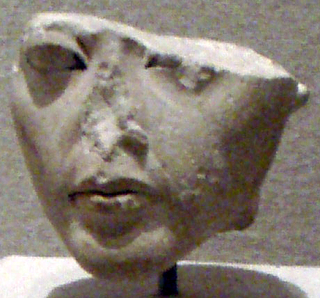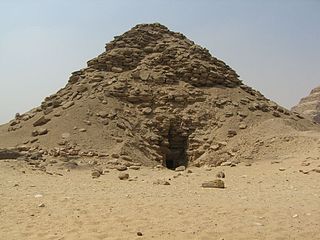Related Research Articles

Ankhesenamun was a queen who lived during the 18th Dynasty of Egypt. Born Ankhesenpaaten, she was the third of six known daughters of the Egyptian Pharaoh Akhenaten and his Great Royal Wife Nefertiti. She became the Great Royal Wife of Tutankhamun. The change in her name reflects the changes in ancient Egyptian religion during her lifetime after her father's death. Her youth is well documented in the ancient reliefs and paintings of the reign of her parents.

The Sixth Dynasty of ancient Egypt, along with the Third, Fourth and Fifth Dynasty, constitutes the Old Kingdom of Dynastic Egypt.

Menkauhor Kaiu was an Ancient Egyptian king of the Old Kingdom period. He was the seventh ruler of the Fifth Dynasty at the end of the 25th century BC or early in the 24th century BC.

Djedkare Isesi was a kng, the eighth and penultimate ruler of the Fifth Dynasty of Egypt in the late 25th century to mid-24th century BC, during the Old Kingdom. Djedkare succeeded Menkauhor Kaiu and was in turn succeeded by Unas. His relationship to both of these kings remain uncertain, although it is often conjectured that Unas was Djedkare's son, owing to the smooth transition between the two.

Neferefre Isi was an ancient Egyptian king of the Fifth Dynasty during the Old Kingdom period. He was most likely the eldest son of king Neferirkare Kakai and queen Khentkaus II. He was known as prince Ranefer before he ascended to the throne.

The Giza pyramid complex in Egypt is home to the Great Pyramid, the Pyramid of Khafre, and the Pyramid of Menkaure, along with their associated pyramid complexes and the Great Sphinx. All were built during the Fourth Dynasty of the Old Kingdom of ancient Egypt, between c. 2600 – c. 2500 BC. The site also includes several temples, cemeteries, and the remains of a workers' village.

The pyramid complex of Userkaf was built c. 2490 BC for the king Userkaf, founder of the 5th Dynasty of Egypt. It is located in the pyramid field at Saqqara, on the north-east of the step pyramid of Djoser. Constructed in dressed stone with a core of rubble, the pyramid is now ruined and resembles a conical hill in the sands of Saqqara. For this reason, it is known locally as El-Haram el-Maharbish, the "Heap of Stone", and was recognized as a royal pyramid by western archaeologists in the 19th century.

Neferneferure was an ancient Egyptian princess of the 18th Dynasty. She was the fifth of six known daughters of Pharaoh Akhenaten and his Great Royal Wife Nefertiti.

Karomama I was an Egyptian queen, married to Osorkon II. She was part of the Twenty-second Dynasty of Egypt.

The pyramid of Djedkare Isesi is a late 25th to mid 24th century BC pyramid complex built for the Fifth Dynasty pharaoh Djedkare Isesi. The pyramid is referred to as Haram el-Shawaf by locals. It was the first pyramid to be built in South Saqqara.

Meresankh II was a queen consort of Egypt who lived during 4th Dynasty.
Meresankh IV was an ancient Egyptian queen believed to have lived during the Fifth Dynasty of the Old Kingdom. Her familial ties are the subject of ongoing speculation.
Meret-Isesi was a Princess of Egypt during the 5th Dynasty. Her father was King Djedkare. Meret-Isesi appears as a King's daughterof his body in a relief which likely comes from Abusir.

Kekheretnebti or Khekeretnebty was a Princess of Egypt, who lived during the Fifth Dynasty. Her father was King Djedkare Isesi.
Neserkauhor was an Ancient Egyptian prince, son of king Djedkare Isesi, during the second half of Fifth Dynasty. Neserkauhor was buried in Abusir, in an area known today as "Djedkare's family cemetery".

Bunefer was an ancient Egyptian queen from the 4th or 5th dynasty. It is not known which king she was married to. Bunefer was buried in tomb G 8408 in the Central Field of the Giza Necropolis.

Tisethor was a princess of ancient Egypt. She may have been a daughter of Princess Kekheretnebti and granddaughter of the King Djedkare Isesi. Her father is not known. She was a niece of Neserkauhor, Meret-Isesi, and Isesi-ankh.

The pyramid of Nyuserre is a mid-25th-century BC pyramid complex built for the Egyptian pharaoh Nyuserre Ini of the Fifth Dynasty. During his reign, Nyuserre had the unfinished monuments of his father, Neferirkare Kakai, mother, Khentkaus II, and brother, Neferefre, completed, before commencing work on his personal pyramid complex. He chose a site in the Abusir necropolis between the complexes of Neferirkare and Sahure, which, restrictive in area and terrain, economized the costs of labour and material. Nyuserre was the last king to be entombed in the necropolis; his successors chose to be buried elsewhere. His monument encompasses a main pyramid, a mortuary temple, a valley temple on Abusir Lake, a causeway originally intended for Neferirkare's monument, and a cult pyramid.

Setibhor was an ancient Egyptian queen consort from the end of the 5th Dynasty. She was most likely the wife of king Isesi. She had several titles including Friend of HorusThe one who sees Horus and Seth, the great one of the hetes sceptre, the great of praise and king’s wife, his beloved.
Nebunebty was an ancient Egyptian queen consort who has been tentatively associated with the 5th Dynasty of the Old Kingdom. Her name translates as 'the gold of the Two Ladies', or 'golden are the Two Ladies'.